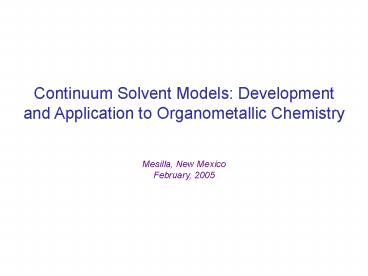Continuum Solvent Models: Development and Application to Organometallic Chemistry PowerPoint PPT Presentation
1 / 22
Title: Continuum Solvent Models: Development and Application to Organometallic Chemistry
1
Continuum Solvent Models Development and
Application to Organometallic Chemistry
Mesilla, New Mexico February, 2005
2
Why is Solvation Important?
- Condensed-phase properties depend on the
condensed-phase wave function, and lt?gasA?gasgt
may be very different from lt?solnA?solngt - Interactions between two (or more) molecules in
solution depend on partial desolvation of each - Potential energy hypersurfaces (and hence
kinetics and equilibria) may be quantitatively
and qualitatively different in solution by
comparison to the gas phase
3
Solvatochromism of Dye ET30 (S1 S0)
4
Catalyst
5
Related Potential Energy Surfaces
6
The Generic Free-Energy Cycle
7
Explicit and Implicit Solvent Modeling Two
Alternative Approaches
- Explicit solvent modeling is conceptually
obvious add lots of solvent molecules and
compute blue curve on last slide - Implicit solvent modeling is more subtle forget
about molecular representation of solvent
compute gas-phase curve by one method, then
compute free energies of solvation at points of
interest by a possibly different method
8
(No Transcript)
9
Some Rules for Implicit Solvent Modeling
- Rule 1 If one replaces the solvent molecules
with a continuum dielectric (an equilibrium
averaging, in essence) one is left with a system
no larger than the solute - Consequence All solvent-structural information
is lost, but if one can afford QM for gas phase,
one can afford QM for solution. Polarization now
arises from first principles (self-consistent
reaction field) - Tricks Numerous methods to solve or approximate
the Poisson equation for continuous or discrete
charge representations
10
Some Rules for Implicit Solvent Modeling
- Rule 2 A continuum dielectric is a fiction, so
it is best not to get too caught up in
theoretical rigor (?GENP is not even a physical
observable? - Consequence Construction of the dielectric
cavity and/or methods for solving the Poisson
equation can vary significantly from one model to
the next - Tricks Parameterization just as important as
for force-field models (even if occasionally it
is stealth-parameterization)
11
Some Rules for Implicit Solvent Modeling
- Rule 3 Electrostatics are only part of the free
energy of solvation - Consequence One needs to somehow account for
cavitation, dispersion, solvent-structural
changes, etc., if one wants to make contact with
the experimental observable - Tricks Its nice if you can also fix up your
electrostatic approximations at the same time
12
How to Account for Nonelectrostatic Terms?
- Ignore them completely (potentially valid for
polyelectrolytes, where electrostatic effects
will be expected to dominate in any case) - Attempt to compute separately using, e.g.,
scaled-particle theory to estimate cavitation
costs, dispersion from models employing atomic or
group polarizabilities, others from? - Assume proportionality to solvent-accessible
surface area of atoms or groups and parameterize
microscopic surface tensions (or surface tension
functionals) - Metals interact so strongly with coordinated
solvent that supermolecular approaches
incorporating the first solvent shell are
typically better than leaving exposed surface
13
Microscopic Surface Tensions
Example The SMx universal solvation models
n is solvent index of refraction ? is solvent
macroscopic surface tension ? is solvent
hydrogen-bonding acidity (Abraham) ? is solvent
hydrogen-bonding basicity (Abraham)
After parameterization (about 74 parameters for
2400 data H,C,N,O,F,S,P,Cl,Br-compounds in 91
solvents including water) SM5.43 has a mean
unsigned error of approximately 0.7 kcal mol1
for neutrals and 5 kcal mol1 for ions this is
roughly 5 for each case
14
Weakly Solvated Metals Permit Surface Tensions
15
Charged Reaction Coordinates are Most Sensitive
16
Solvation Affects Termination via ?-Hydride
Elimination
17
Example Dimerization of Lithium
CarbenoidsPratt et al. J. Org. Chem. 2002, 67,
7609
Three dimer microsolvates
Two monomer microsolvates
What concentration of carbenoid is required to
see equal amounts of monomer and dimer in
solution?
c0 0.22 M readily achievable
Protocol mPW1PW91/MG3S//mPW1PW91/MIDI! for
gas-phase G173, solvation free energies from
relaxed GB SCRF/mPW1PW91/MIDI! Working in 1 M
standard state
18
Mechanism of Oxygenation?How is O2 activated at
single Cu site?
CH3CN
19
Stop-flow Kinetics for Oxygenation
20
Microscopic Mechanism from Theory(black line,
298 K gas phase red line, 223 K THF solution)
Rate determining step is addition of oxygen
Rate determining step precedes addition of oxygen
Expt. 18 2 100 10
Expt. 30 2 98 10
Theor. 14.9 108
Theor. 27.2 101
21
(No Transcript)
22
(No Transcript)

